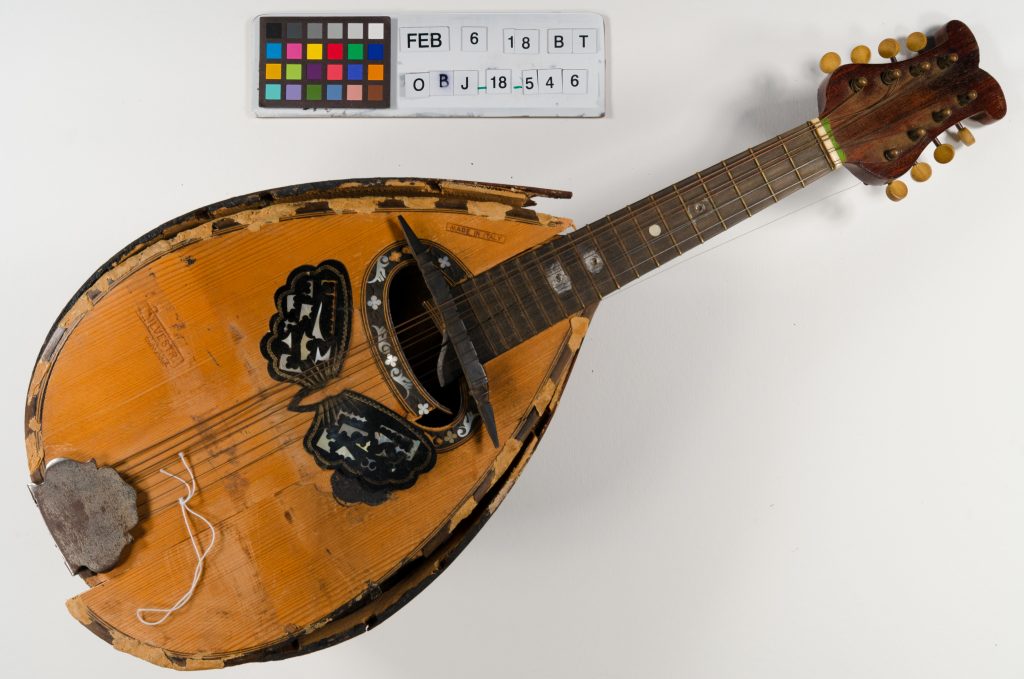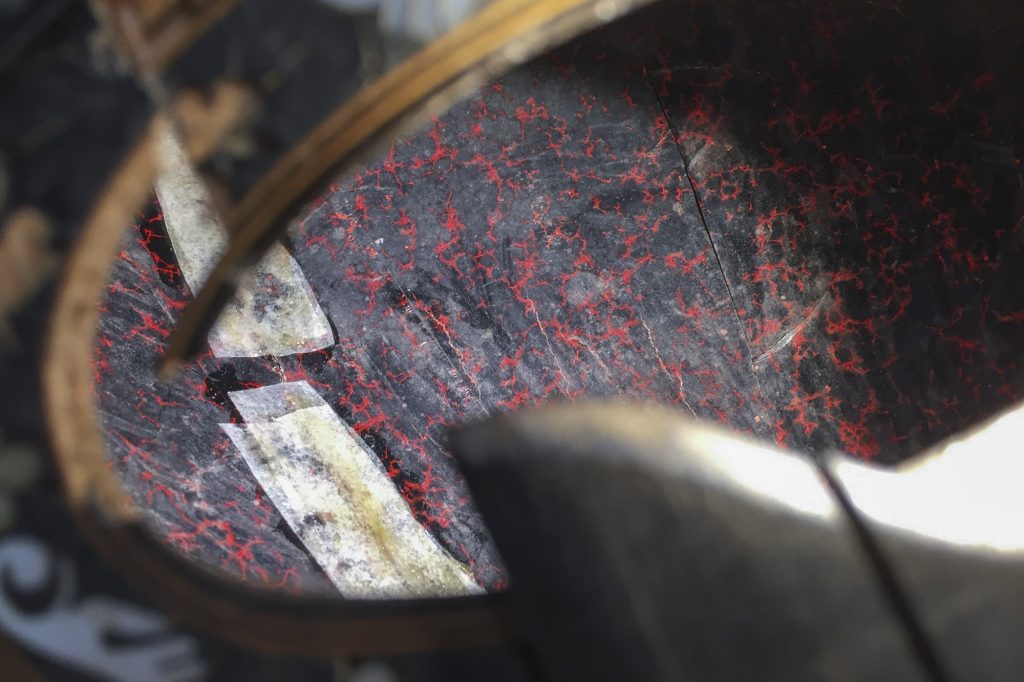To ‘mendolin’ or not to ‘mendolin’
by Katrina Watson
Part One: The ethical dilemma of determining significance and treatment aims for an object with an unknown past
In conservation, treatments often involve ethical dilemmas. To assist us, we use information about the material and non-material aspects of objects to decide not only its significance, but to determine treatment choices (Appelbaum 2012). Supplementing this are codes of ethics that encourage us to make informed decisions based on respecting the ‘physical, historic, aesthetic and cultural integrity’ objects (AICCM 2002). Finally, guidelines promote the importance of objects to people, communities and cultural life, and help to decide on resources since not everything can be kept forever (Russell & Winkworth 2009). Common to all is the importance of the story and history of the object.
How, then, do you ethically complete a conservation treatment on an object with all the marks and scars of a life well lived but no information about how it acquired them?
The object in question is a mandolin (Figure 1), an object that Scholes described as being like a lute but ‘much less artistically valuable’ (1985, p. 596). The term ‘mandolin’ is often used to describe a wide variety of instruments with ‘distinct histories, repertoires and playing techniques’ (Sparks 1989, p. 11). Coates describes the vast array of mandolin types as like reading ‘the menu of spaghetti dishes at one’s local trattoria’ with variations based off two main spaghetti dishes—Milanese and Neapolitan (1977, p. 75). This mandolin is consistent with the Neapolitan style (Sparks 1989; Tyler 1981). It is stamped with the words Silvestri / Catania / made in Italy, indicating production by the liuteria Silvestri in the Sicilian city of Catania. The date of its manufacture is unknown. It also comes in a homemade soft case.

The mandolin is in poor condition — it has multiple complex structural issues, rendering it unplayable. Assessing significance is made more difficult due to multiple factors. There is limited information about its creator, Silvestri, barring location and that Silvestri mass-produced instruments (Jonas 2010a, 2010b). In addition, there is no information on its local context other than being part of the Bathurst District Historical Society collection. This mandolin may have historic or social significance, perhaps as part of the post-World War Two migration to the area, but this too is ultimately an unknown (NSW Migration Heritage Centre 2010). This lack of information and poor condition of the mandolin make it difficult to gauge its significance. What is known is that the mandolin clearly belonged to someone, however. It has a history with previous repairs, applied with knowledge of either this mandolin or mandolins in general in an attempt to match decorative styles (see Figure 2).

In the end, we need to return to concrete conservation concepts that seek to protect objects by minimising ‘chemical and physical deterioration and damage’ and further loss of information, to prolong the life of the object until its significance can be used to better inform treatment options (AICCM 2002). As such, it would almost be unethical to do nothing. Thus this treatment will aim to:
- Stabilise the object by using sustainable and ethically weighed treatments to prevent further structural and chemical / corrosion deterioration that could lead to a reduced life span
- Return its aesthetic value by maintaining the overall current used / repaired state
Part Two: Letting go of all the tension to put it under pressure
In the first instalment, the ethical dilemmas of determining significance and treatment aims were discussed for an object with no historical information. This instalment gets into the ‘nitty-gritty’ of the conservation treatment.
Letting go of all the tension
The strings of a mandolin can place enormous amount of tension on its body (Croen 2010; Pollens 2015). To complicate matters, a mandolin is constructed using of several types of wood, each with anisotropic properties—having different physical characteristics and properties dependant on grain. This results in differing rates of swelling and shrinkage when exposed to changes of relative humidity and temperature (Pollens 2015; Rivers & Umney 2003). This inherent vice often results in structural failure as is the case with the Bathurst mandolin. However, the most pressing of the structural issues and most likely to cause future issues is the splintered bowl (Figure 3).

To fulfil the treatment aims, the bowl needed to be slightly reshaped to facilitate repairs. The first step to achieving this is relieving the tension on the body by removing the strings and metal elements, as shown in the video below.
Putting it under pressure
The bowl of the mandolin is warped and needed to be slightly reshaped to assist with the adhesion of the splintered section. Humidification was considered, as it is a traditional method of reshaping materials (Rivers & Umney 2003). However, this was considered a risky option for the mandolin due to:
- The combination of multiple types of woods and tensions increasing the likelihood of ‘differential shrinkage’ (Rivers & Umney 2003, p. 730)
- An inability to adequately brace or clamp the bowl
- The possible negative effectives on the hygroscopic hide glue (Horie 2010, p. 232; Schellmann 2007)
As an alternative, a frame was constructed that could apply constant, incremental pressure to the bowl that was increased week,

by week,

by week.

So now we wait …
Part Three: To ‘mendolin’ or not to ‘mendolin’, the final instalment
For a period of three and a half weeks increasing pressure was applied to the mandolin to help reshape it for repair to the splintered section of the bowl. The frame in addition to applying pressure acted as a very stable and safe platform from which to carry out a serious of treatment steps on the mandolin.
During this time the mandolin underwent:
- Dry cleaning of the case, wood and metal elements to remove surface dirt
- Mechanical removal of previous repairs around the area of the splintered bowl
- Testing to determine appropriate materials for safe wet cleaning and consolidation. This consisted of:
- solubility, pH and conductivity profiling of the mandolin and case surfaces;
- metal spot testing to determine the plating material on the tailpiece;
- solubility testing of solvent carriers for the consolidation of the surface of the case.
- Wet cleaning of the case and top of the mandolin to remove ingrained dirt
- Wet cleaning and treatment of corrosion, followed by coating of metallic elements
- Consolidation of crumbling surface of case
- Creating a box for rehousing
Bit by bit, putting it together
As previously stated, the splintered section of the bowl presented the biggest potential threat to the stability of the mandolin. The mandolin, however, also has a paper lining which was cracked and peeling and no longer acting as reinforcement for the bowl (Rovetta et al. 2015). Hide glue was used to adhere the splintered section of the bowl section in addition to reinforcement of cracks in the bowl, as shown the following video:
Once the gluing was completed, infilling and in-painting followed in order to blend the need repairs to the original wood and internal paper.


The treatment was followed by restringing of the mandolin, after-treatment photography and rehousing.


Acknowledgements
I would like the thank the lecturers at the Grimwade Centre for Cultural Materials Conservation and Robin Hodgson for their aid in this project and the Bathurst District Historical Society for generously allowing me to work on this object.
References
Appelbaum, B 2012, Conservation Treatment Methodology, Elsevier Butterworth-Heinemann, Oxford, UK.
Australian Institute for the Conservation of Cultural Materials 2002, AICCM code of ethics for the practice of conservation of cultural material in Australia, AICCM Inc., Canberra, Australia.
Australian Institute for the Conservation of Cultural Materials (AICCM) 2002, Code of Ethics and Code of Practice, AICCM Inc., Canberra, Australia, viewed 9 February 2018, <https://aiccm.org.au/about/code-ethics-and-practice>.
Croen, TO 2010, ‘Stabilizing a neck’, in T Wilder (ed.), The conservation, restoration, and repair of stringed instruments and their bows.vol. 2 Stringed instruments and techniques for their conservative restoration and repair, IPCI-Canda Archetype Publications, Montreal, Canada.
Coates, K 1977, ‘The Mandoline: An Unsung Serenader’, Early Music, vol. 5, no. 1, pp. 75-87.
Federazione Mandonlinista Italiana 2005, Mandolino Ermelinda Silvesti, Roma, 640x480px, photograph.
Horie, CV 2010, Materials for Conservation, 2nd edn, Butterworth-Heinemann, Oxford, UK.
Jonas, M 2010a, Re: Can someone give me info on this mandolin, Mandolin Cafe Forum, 21 July 2010, forum reply, <https://www.mandolincafe.com/forum/showthread.php?64135-Can-someone-give-me-info-on-this-mandolin&p=822020#post822020>.
Jonas, M 2010b, Re: Info on Silvestri Mandolin 1891?, Mandolin Cafe Forum, 14 February 2010, forum reply, <https://www.mandolincafe.com/forum/showthread.php?59394-Info-on-Silvestri-Mandolin-1891>.
NSW Migration Heritage Centre 2010, Belongings. Post-WW2 migration memories & journeys, Powerhouse Museum, viewed 12 March 2018, <http://www.migrationheritage.nsw.gov.au/belongings/indexc0ba.html?migrantaccommodation=bathurst>.
Pollens, S 2015, The Manual of Musical Instrument Conservation, Cambridge University Press, Cambridge, UK.
Rivers, S & Umney, N 2003, Conservation of Furniture, Butterworth-Heinemann, Oxford, UK.
Rovetta, T, Canevari, C, Festa, L, Licchelli, M, Prati, S & Malagodi, M 2015, ‘The golden age of the Neapolitan lutherie (1750-1800): new insights on the varnishes and decorations of ten historic mandolins’, Applied Physics A: Materials Science & Processing, vol. 118, no. 1, pp. 7-16.
Russell, R & Winkworth, K 2009, Significance 2.0: a guide to assessing the significance of collections, 2nd edn, Collections Council of Australia Ltd., Rundle Mall, Australia.
Schellmann, N 2007, ‘Animal glues: a review of their key properties relevant to conservation’, Studies in Conservation, vol. 52, no. Supplement 1: Reviews in Conservation 8, pp. 55-66.
Scholes, PA 1985, The Oxford companion to music, 10th ed. rev. and reset edn, Oxford University Press, Oxford, UK.
Sparks, PR 1989, A history of the Neapolitan mandoline from its origins until the early nineteenth century, with a thematic index of published and manuscript music for the instrument, unpublished Doctoral Thesis , City University of London, UK, viewed 4 March 2018, <http://openaccess.city.ac.uk/7412/>.